
The First and Only Weekly Online Fanzine Devoted to the Life and Works of Edgar Rice Burroughs Since 1996 ~ Over 15,000 Webpages in Archive |

The First and Only Weekly Online Fanzine Devoted to the Life and Works of Edgar Rice Burroughs Since 1996 ~ Over 15,000 Webpages in Archive |
At least two of the original fantasy paintings that U.S. Marines found in Saddam's "love nest" were painted by Rowena Morrill. One of these paintings had been produced as the cover for the fantasy novel King Dragon by Andrew J. Offutt. This painting was based on one of 50 illustrations drawn by Esteban Moroto for a proposed Ace Books illustrated edition of ERB's At the Earth's Core. When the Ace project fell through the publishers commissioned Offutt to write a novel around the illustrations. The result was the novel King Dragon with a cover painted by Rowena based upon one of Moroto's Pellucidar drawings of the sacrifice of a girl to a mahar.
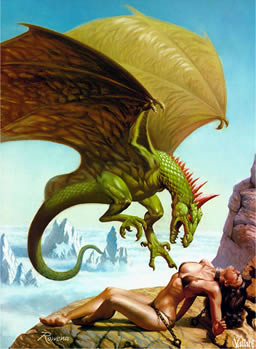 |
Fantasy Art in Saddam Love Nest April 23, 2003
The New York Daily News reported that two paintings found in a townhouse apparently used as a love nest by deposed Iraqi ruler Saddam Hussein were fantasy book covers by Rowena. According to the report, Rowena found out about the paintings when her sister called to tell her she'd seen them in a news story. They were originally painted as book covers for King Dragon and Shadows Out of Hell, fantasy paperbacks published in the 80s. Both paintings were sold years ago, King Dragon to a Japanese collector for $20,000. Rowena told the reporter she hadn't heard anything about either painting since she sold them, but that she'd like them back now. The paintings belong to the yet-to-be-formed successor government of Iraq. |
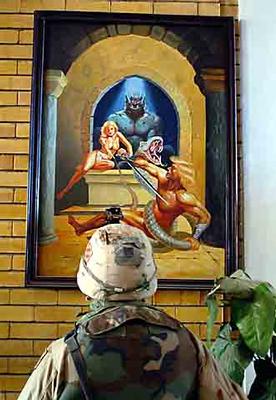
U.S. Army 1st Lt. Eric Hooper looks upon a fantasy painting in a house in an upscale neighbourhood of Baghdad. |
Rowena Morrill Saddam Hussein's favorite painter speaks! DazeReader.Com The artist known as Rowena admits her fantasy-art paintings — filled with snarling dragons, Fabio lookalikes and buxom damsels — can attract an offbeat clientele. But Saddam Hussein? The upstate New York painter was stunned to learn two of her campy, sexually charged artworks wound up at the tyrant's love shack in Baghdad. And now she wants her '80s-vintage paintings back — taloned serpents, bare-breasted babes and all. "I would give anything to get them back," said Rowena, whose last name is Morrill but prefers using only her first name. "I am so upset that they are there." The painting from earlier this week, with the "busty blond . . . conjuring up a forked-tongued serpent to wrap itself around the body of a hunky bare-chested warrior," was originally done for the cover of Shadows Out of Hell, a 1980 fantasy novel by Andrew Offutt. Saddam also had this Rowena painting entitled "King Dragon" in the same house. |
Baghdad - The doors of the townhouse opened to reveal a playboy's fantasy straight from the 1960s: mirrored bedroom, lamps shaped like women, airbrushed paintings of a topless blonde woman and a mustached hero battling a crocodile. Troops thought it was the home of President Saddam Hussein's mistress, though on the wall and in the bedroom were photos of the Iraqi president and a woman who appeared to be his wife. The company commander suspected they had found one of the Iraqi leader's many safe houses. "This must have been Saddam's love shack," said Sgt. Spencer Willardson of Logan, Utah.The split-level, one-bedroom townhouse is in a Baath party enclave in an upscale neighbourhood in central Baghdad where generals and senior party officials lived. As U.S. officials set up command posts there, troops were going house by house, searching for looters and weapons. Next door, where iron sheets were welded over all the windows, they found more than 6,000 Berretta pistols, 650 Sig Sauer pistols, 248 Colt Revolvers, 160 Belgian 7.65 mm pistols, 12 cases of Sterling submachine-guns and four cases of anti-tank missiles all still in the unopened original boxes. There were also tens of thousands of rounds of ammunition mortars and cases of old handguns and heavy machine-guns.
Not far off was another presidential palace, this one with a Yugoslav-built, chemical and biological weapons-proof bunker underneath it. A U.S. army team inspected it and it appeared to be strictly defensive in nature. But this home was different: beanbag chairs, a garden of plastic plants, a sunken kitchen and a room for a servant, all 1960s-style. The sunken wet bar was stocked with 20-year old Italian red wines and expensive cognacs, brandies and Scotch whiskeys, the same brands found in several presidential palaces. The glassware, too, was the same pattern that was found in at least three palaces also visited by U.S. troops since the regime collapsed. The pattern features the Iraqi government seal and a gold pattern on that rim.
Capt. Chris Carter, commander of A Company, 3rd Battalion, 7th Infantry Regiment, said the home appears to be one of Saddam's safe houses. Officials concluded the house was used by Parisoula Lampsos, who publicly claimed to be Saddam's mistress. She escaped to Lebanon in 2002. Saddam's wife, Sajida Khairallah Telfah, is also his cousin. Together they had three daughters and two sons, Odai and Qusai. Like her husband, her whereabouts are unknown. Saddam is widely known to have a third son, Ali, by another woman. Lampsos was interviewed extensively about her relationship with Saddam on U.S. television. Her current location is unknown and she was last believed to be in hiding.
The photos show Saddam and a woman smiling at each other and standing beside one another - in one Saddam wears a uniform and in another a suit. On one wall was a plaque of the Iraqi eagle and flag seal. Upstairs was a television room with bright blue, pink and yellow throw pillows. The bathroom included a whirlpool bath. The kingsized bed was fitted into an alcove with mirrors on two sides and a fantasy painting on the third. The closets and drawers were empty except for a man's nightshirt, two pairs of boxer shorts, two T-shirts and a bath robe - each item individually wrapped in plastic, just as similar items had been in the palaces.
One of the airbrushed paintings depicted a topless blonde woman, with a green demon behind her, pointing a finger at a mythic hero. From the tip of her finger came a giant serpent, which had wrapped itself around the warrior. Another showed a buxom woman chained to a barren desert mountain ledge, with a huge dragon diving down to kill her with sharpened talons.
The home's 1960s look - parodied in the series of Austin Powers spy spoofs - inspired a round of imitations from soldiers slogging door to door. "Yeah, baaabeee," said Carter, doing his best imitation of actor Mike Myers' character. "Shagadelic," another soldier shouted. Indeed, the carpet was navy-blue shag.
Shag-dad art is mine!
By Dave Goldiner
New York Daily News
Tuesday, April 15th, 2003
The artist known as Rowena admits her fantasy-art paintings - filled with snarling dragons, Fabio lookalikes and buxom damsels - can attract an offbeat clientele. But Saddam Hussein?The upstate painter was stunned to learn two of her campy, sexually charged artworks wound up at the tyrant's love shack in Baghdad. And now she wants her '80s-vintage paintings back - taloned serpents, bare-breasted babes and all. "I would give anything to get them back," said Rowena, whose last name is Morrill but prefers using only her first name. "I am so upset that they are there." "I utterly hate Saddam Hussein," she said. "I loathe everything he is and everything he stands for."
Rowena, 58, said she did the oil paintings that hung in the dictator's den about 15 years ago as covers for bodice-ripper paperbacks with titles such as "King Dragon" and "Shadows Out of Hell." A busty blond is depicted in one painting conjuring up a forked-tongued serpent to wrap itself around the body of a hunky bare-chested warrior. In another, a chained woman clad in a tattered bikini arches her back as a dragon's talons reach toward her. Rowena knows no one would ever confuse her with Picasso or Goya - and insisted her more recent works are much better. "I know they're not the Madonna by Leonardo da Vinci," she said. "They were high camp. I always found them hilariously funny."
Rowena was a classically trained artist who studied in Italy but took up the fantasy genre to support herself after moving to New York in the late '70s. "I was looking for a way to make a living, and it paid the rent," she said by phone from her home near Albany. She sold the two paintings years ago - the one with the dragon went for $20,000 to a Japanese collector - and hadn't heard about them since.
On Sunday, Rowena's sister called to say she had seen one of the paintings on TV hanging in a secluded townhouse in Baghdad. The pad is believed to have been used by Saddam to squire his girlfriends. Rowena said she still can't believe something in her artwork might have touched a chord in someone as evil as Saddam. "That would be a horrifying thought," she said. "He in his twisted mind must have read something into it." Though she knows she likely has no legal claim to the paintings, she wants them back. "I don't like the idea of them being in that country," she said. Navy Lt. Charles Owens, a spokesman for the U.S. Central Command in Qatar, said Rowena will have to wait to take her case to a new Iraqi government, which will take control of all of "Saddam's assets."
Don't laugh at Saddam's art collection
By Franklin Harris
April 24, 2003
Pulp CultureSome people collect Picassos. Others collect Van Goghs. Then there is Saddam Hussein.
When U.S. troops raided one of Saddam's Baghdad safe houses, which they dubbed the "love shack" because of its Austin Powers décor, they found the walls covered in fantasy paintings. You know the type — heroic and usually erotic renderings of barely clad, well-muscled warriors and maidens, usually either in chains or in battle with some mythological beast.
Rowena Morrill recognized two of the paintings as hers, and she wasn't happy. She painted them 15 years
ago for the covers of a couple of paperback sword-and-sorcery novels, then two years ago she sold them. A Japanese collector paid $20,000 for one depicting a woman threatened by a dragon. But Morrill doesn't know how they became part of Saddam's collection."I would give anything to get them back. I am so upset that they are there," Morrill told a reporter with the New York Daily News. "I don't like the idea of them being in that country. I'm the one who slaved over them. I worked very hard for them, and I am very attached to them." Of course, she wasn't so attached that she couldn't sell them, but never mind.
The paintings became a running joke on the cable news channels. Everyone had a good laugh at Saddam's supposedly tacky taste in art. "These are art for the barely literate, or the barely sentient, dredged from some red-lit back alley of the brain," wrote Jonathan Jones in London's left-wing rag of record, The Guardian. "They are from the universal cultural gutter — pure dreck." Obviously, it is left to me to defend Saddam, or rather to defend his artistic sensibilities.
While Morrill may be defensive, fretting over how her works possibly could appeal to someone as evil as Saddam, I think it's natural. Tyrants never view themselves as tyrants. Instead, they see themselves as heroic, often absurdly so. So, of course, heroic art appeals to them. That doesn't make the art evil. (In the case of Soviet Realism, however, it does make it bad.) Critics like Jones hate fantasy art because it is unabashedly commercial (as if Michelangelo ever worked without pay). It exists not primarily for its own sake, but to sell books, movies and calendars.
Still, fantasy art has a devoted following. Books collect the works of artists like Morrill, Boris Vallejo, Julie Bell and Frank Frazetta. Their art appears at shows and in galleries. And, of course, collectors pay thousands of dollars for original paintings. Every genre has its hacks, but Frazetta isn't one of them. His illustrations have become the standard for fantastic art, as have his visions of fictional worlds spanning John Carter's Mars, Tarzan's jungle and Conan the Barbarian's Hyborean Age.
Clint Eastwood was enough of a Frazetta fan that he asked the artist to paint the movie poster for the 1977 police thriller, "The Gauntlet." The result is reminiscent of a "Conan" book cover, which is exactly what Eastwood wanted. Modern fantasy art isn't from some "universal cultural gutter." Rather it comes from a distinctly American literary tradition, which originated in early 20th century pulp magazines.
It's not something to laugh at, no matter on whose wall it hangs.
Just how much can an art collection reveal about a guy? Consider Hitler's taste for mythological soft porn, like Paul Mathias Padua's Leda and the Swan (in which the big guy in feathers is depicted in flagrante fortissimo with a sweet young thing). If only we could have seen that predilection for what is was: evidence of a dangerously repressed sexuality, and a penchant for violent domination. Diagnosis: psychotic delusions brought on by severe testosterone poisoning.In light of the atrocities committed against the Iraqi people and other unfortunates over the past 30 years, it is undoubtedly beside the point to criticize Saddam Hussein for his aesthetics. Still, one of the more tantalizing discoveries of the last few days, as we peel back the onion layers of his regime, has been the revelation of the dictator's taste is art. Among the more lurid treasures to heave into view are the fantasy paintings of American (oh irony of ironies!) painter Rowena Morrill, or just plain Rowena -- she prefers, like Cher, to go just by her first name -- a native of the town of Coxsackie, in upstate New York.
No one knows how the painter's works ended up in the possession of Saddam. Rowena herself was ignorant of the fact until her sister phoned and said she had seen her art on CNN. The 58-year-old sci-fi painter moonlights as an illustrator, and her paintings often serve as cover art for trash fiction. "I know they're not the Madonna by Leonardo da Vinci", the artist has said. "They were high camp. I always find them hilariously funny."
The artist is a little spooked, though, to find that her paintings have struck a reverberating chord in the axis of evil. Asked by phone what she thinks Saddam saw in her art, she sounds mystified. "Number one: I think he's a madman. The thoughts of someone like that are incomprehensible to me because my perspective is one of a normal person. I would say, though, that the female version of beauty is very voluptuous in the Middle East. Maybe that was what it was." American troops found the pictures in one of Saddam's many Baghdad safe houses, a hideout from would-be assassins and a playpen for amorous trysts.
"That would be a horrifying thought," she says, "He, in his twisted mind, must have read something into it." Like what? Well, it seems the appeal of patriarchy is the same the whole world over. The paintings are the kind of pumped up, side-of-a-van type art that goes best with a bong and some black lights. Rowena, who grew up in Japan, says they reflect her love of exoticism. "I love demons and temples and dragons," she says. "There, they are often symbols of luck. They are not always bad guys."
In one piece, a damsel in bondage is pawed at by a salivating dragon, her back arching daintily to escape the reach of his horny claws. In another, a bare-breasted beauty looks on -- helplessly, of course -- as a heroic, sword-wielding Fabio-clone wrestles for his life with a giant serpent. Rowena is nonplussed by the accusation of sexism in her work; "It's the natural order of things that it's going to be the girl getting rescued by the man," she says. Here, she offers up a double-heaping of phallic imagery: both snake and sword. (Why not just prop up a Scud missile in the corner and wheel on the hot-dog cart?) Behind the hero and heroine, a diabolical monster presides from his pedestal, exuding a kind of steroid-enhanced masculinity gone wrong, and a plethora of facial horns -- as if more insignia of rutting maleness were required.
Paintings by other artists in Saddam's cache reveal similar themes, like the dungeon scene depicting a swarthy male prisoner chained to a pillar, his hands behind his back. Knee deep in floodwater and clad only in his crimson loincloth (which just barely covers the family jewels), he looks on in terror as a crocodile approaches, snapping its grisly jaws. (A touch of castration anxiety, perchance?) Then there's the painting of the great fat snake coiled in a tree. (Serpents, no surprise, are just busting out all over.) From its perch, the forked-tongued menace spies a raft full of survivors being swept downstream in a raging river. Overhead, a military plane spewing flames dives down toward the horizon. What have we here? A trailer for Showdown Iraq? Stealth, threat, revenge, bondage -- what better for over the sofa chez Saddam?
But before we get too snarky, how's the art looking at our own presidential palaces? Well, on a quality level, you'd have to call it a draw. Bush's favourite is a picture called Rio Grande, a 1954 canvas by Texan cowboy artist Tom Lea that is on loan to the Oval Office from the El Paso Museum of Art. Where Rowena is all orgiastic gushing and diaphanous harem pants pulled taught over hard-boiled buttocks, the President's taste runs to the suspiciously sterile. In fact, the Lea classic depicts a desolate desert landscape peopled only by one giant cactus (that thrusting shape again!), all crusted over with spines. You can say what you want about family values, but the White House is looking like a bit of a dustbowl to me.
The paintings hanging in Saddam's palaces show a mind obsessed with sex and violence, writes Jonathan Jones. It is all satisfyingly horrendous - almost the smoking gun. The paintings of naked blonde maidens menaced by dragons and trolls, warriors wrestling serpents and a wet dream of missiles that have been found in Saddam Hussein's palaces and love shack feel like proof of something. They appear to reflect the man's authentic pleasures and interests or, at the very least, the culture of Saddam's court.That's certainly how the photographs make it seem. In lieu of American soldiers posed next to chemical warheads, we have an American soldier contemplating a mural of massed rockets framed in an arched recess between purple marble columns in one of Saddam's Baghdad palaces. We may not yet have found weapons of mass destruction - but just look at this proof of the dictator's execrable sensibility.
The downfall of dictators is always somehow tinged with pathos. You think of the Emperor Nero on the brink of his
suicide, proclaiming insanely, "What an artist I die!", or Hitler in his bunker studying a model of the ideal Nazi city as the Russians advanced through Berlin. Poor aesthetic judgement is an archetypal part of this wretchedness - all that vulgarity exposed.The art in Saddam's palaces is the embodiment of ideas and appetites and, as such, it is not really that funny. The erotic art is particularly recognisable as the sort of thing you'd see in Hitler's private collection - right down to the Aryan types. One of Hitler's favourite paintings was Paul Mathias Padua's Leda and the Swan, with a German maiden about to be penetrated by a Wagnerian swan.
But Saddam is less elevated in his taste than Hitler. The Fuehrer was more pretentious: Leda and the Swan is a classical myth. By contrast, there are no high cultural allusions whatsoever in the Saddamite paintings. They're certainly not Islamic - in early medieval Iraq the brilliant art of the Abbasids included splendid palaces with figurative decorations celebrating the pleasures of the ruler: hunting, food, music. There's not much that is culturally embedded about his taste in paintings.
They are from the universal cultural gutter. They look spraypainted, in a rampant hyperbolic style where all men are muscular, all women have giant breasts and missiles are metal cocks. These are art for the barely literate, or the barely sentient, dredged from some red-lit back alley of the brain.
And what are those monsters in the erotic paintings? For a start, it's difficult to see that they are necessarily depicted as enemies. The viewer identifies with them. A dragon descends on a defenceless naked woman, the movement and force of the picture makes the dragon the male sexual actor, as in the image of Leda and the Swan. In the painting of a male warrior fighting a snake while a big-breasted woman on an altar touches the end of its tail, it's not so much a rescue going on as a psychic breakdown - the warrior isn't going to "liberate" anyone with his sword.
Looking at these paintings is like seeing the owner naked. "Embarrassing" isn't the word. They seem to represent a
systematic style and therefore a sensibility. The hysterical aesthetic, the hyperpornography of power and violence which does not just seem coincidence. And if this is the authentic taste of Saddam, it is that of a man who seems on this evidence to have lived according to aestheticised, eroticised violence for which no one has yet come up with a better word than "fascism".
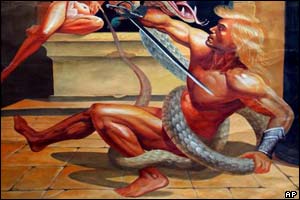
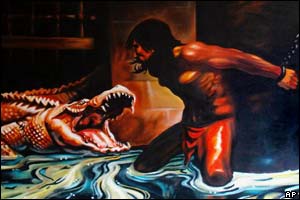
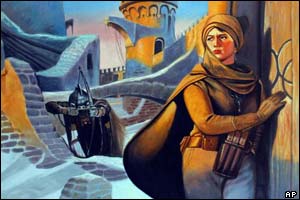
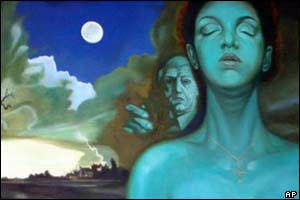
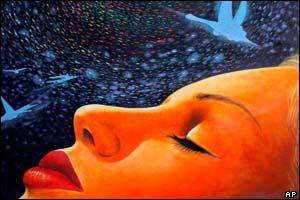
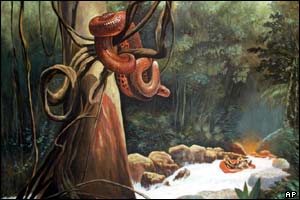

Andrew J. Orffutt |
1979 Iron Lords
|
| Andrew J. Orffutt Series:
Conan
Cormac Mac Art
Thieves' World universe:
War of the Gods on Earth
War of the Wizards
Swords Against Darkness
|
1970. Evil is Live Spelled Backwards
1972. Castle Keeps 1973. Ardor on Aros 1973. Galactic Rejects 1973. Messenger of Zhuvastou 1975. Genetic Bomb 1975. Sword of the Gael 1976. Black Sorcerer of the Black Castle 1976. Chieftan of Andor 1976. Undying Wizard 1977. Mists of Doom 1977. My Lord Barbarian 1977. Swords Against Darkness 1977. Swords Against Darkness II 1978. Conan and the Sorcerer (Amazon - Alibris) 1978. Demon in the Mirror 1978. Swords Against Darkness III 1979. Conan the Sword of Skelos 1979. Iron Lords 1979. Swords Against Darkness IV 1979. Swords Against Darkness V 1980. Conan the Mercenary 1980. Eyes of Sarsis 1980. King Dragon 1980. Shadows Out of Hell 1980. When Death Birds Fly 1981. Web of the Spider 1982. Tower of Death 1983. Lady of the Snowmist 1984. Sign of the Moonbow 1987. Shadowspawn 1990. Deathknight 1993. Shadow of Sorcery |
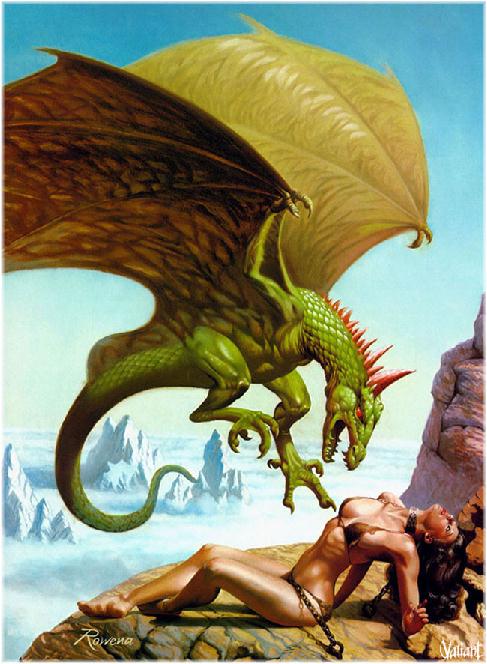
Rowena Morrill Website
Rowena
Gallery
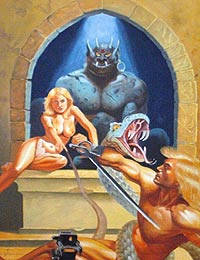
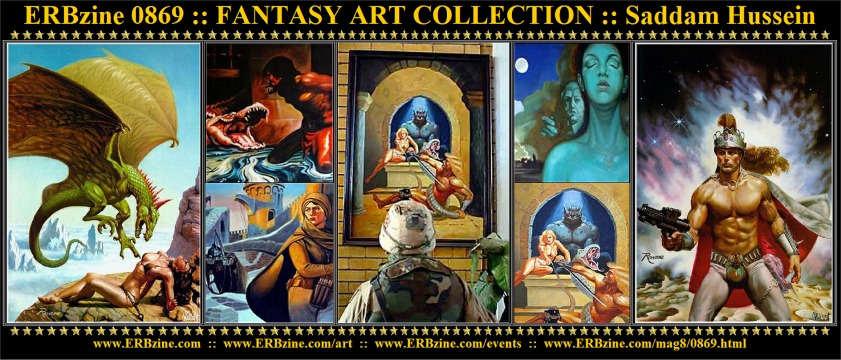
Click for full-size promo splash bar
![]()
![]()
Volume
0869

WEBJED:
BILL HILLMAN
Visit
our thousands of other sites at:
BILL
and SUE-ON HILLMAN ECLECTIC STUDIO
All
ERB Images© and Tarzan® are Copyright ERB, Inc.- All Rights Reserved.
All
Original Work © 1996-2003/2010/2020 by Bill Hillman and/or Contributing
Authors/Owners
No
part of this web site may be reproduced without permission from the respective
owners.